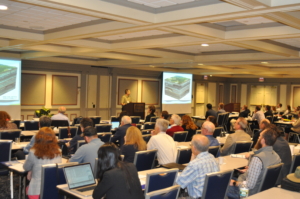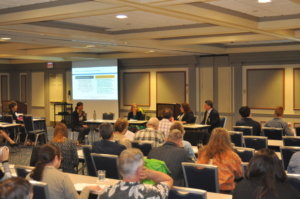Shale Network Workshop at Penn State
The Marcellus Shale region in Pennsylvania is famous for its large quantities of shale gas reserves. Fracking of these reserves has led to water quality impacts, endangering human health. To better understand the risks, scientists want more data on water quality from across the region.

Picture from the 2019 Shale Network workshop. Credit: Francisco Tutella
That’s why the Shale Network is working to collect data from non-scientific sources in order to understand and find solutions for problems around shale. Since 2012, the group has hosted an annual workshop that brings together researchers, shale industry leaders, and policy makers to connect on broad issues.
“It’s a good opportunity to talk science with a lot of different stakeholders,” said Dr. Susan Brantley, Distinguished Professor of Geosciences at Penn State. Brantley was one of the people who established the Shale Network by writing a proposal to the National Science Foundation in response to growing demand of shale gas from the region.
In the past two decades, extraction of shale gas has exploded in Pennsylvania, due largely to improvements in hydraulic fracking techniques. Researchers are now racing to figure out the environmental impacts and connect the different stakeholder groups.
Understanding problems with shale extraction and data collection
There are now thousands of shale wells across Pennsylvania, and some of the wells have caused serious water quality problems for locals. “With a project at this big of a scale, there are going to be problems,” noted Brantley. But, she added that of the approximately 10,000 wells in Pennsylvania, only a small percentage of them have problems.
Her goal is to quantify the number of issues and broadly publicize information about how shale extraction actually affects the environment, asking “what is the percentage of needles in the haystack.”
In order to paint that picture, Brantley is looking at both case studies and large data sets to understand different parts of the issue. But finding information of both types can prove challenging.
Brantley uses case studies to inform models that predict how malfunctions in extraction might have occurred. While large amounts of data can show trends and issue areas, case studies allow researchers to understand specific problems and how to avoid them in the future.
For example, Brantley recently published a case study for a set of problem gas wells in Bradford County, PA. There was a lot of natural gas and white foam in drinking water in a few domestic water wells within 2-kilometers of the shale gas wells. She published a geological explanation of what she thinks happened: the wells weren’t cased in cement at intermediate depths, allowing movement of gas in the intermediate depth rock layers upward into aquifers.
“We still can’t prove exactly what happened, but we can make scientific models of what happened and peers can evaluate our likely explanation,” said Brantley.
Figuring out exactly what happened can prove difficult if companies don’t want the stories published. “Sometimes companies don’t want to admit there are any problems,” explained Brantley.
How to get shale stakeholders talking
Brantley also collects large amounts of water quality data to understand big picture problems, but admits it can be difficult for stakeholders to share. “No one likes to share data,” she said, and explained how academics sometimes hoard data for future publications, and governments might keep data private because it has confidential information and scraping that takes time.
Gas companies often hide data because of worries about liability. When issues happen, and a company is forced to pay out for mitigation, their settlements often stipulate that the victim can’t release associated data.
Homeowners are often reluctant to share information– worried about the value of their property deteriorating because of groundwater data.

Another picture from this year’s workshop. Credit: Francisco Tutella
Brantley helped start the Shale Network to overcome these challenges and get everyone talking to each another. The Shale Network’s annual workshop started as a small meeting but has grown to 110 participants this past May.
It is now co-hosted with the University of Pittsburgh with a steering committee drawn from academia, government, industry, and watershed groups. “The DEP sends more and more people every year,” said Brantley, “which gives them the opportunity to articulate the rules they use and the rules they need.”
Brantley and Penn State have been working closely with the Pennsylvania Department of Environmental Protection (DEP) to access water quality data.
Brantley’s group is working to get 20,000 data points online by hiring students to scrape the data. Then, her team compares current groundwater data with past data to see how the water quality has changed over time.
The annual workshop provides a forum for collaboration among academics, industry leaders, and policy makers to address challenges and solution. For academics, Brantley says, “I hope they get a broader appreciation of the problems. If you only look at water quality and not economics, you’re only getting a small piece of the picture.”
She hopes that by attending the conference, companies and government employees will feel more comfortable talking to the public. “I would like for them to feel like they have academics they can reach out to when they have technical problems… In the end, everybody leaves and they tell us how much they learned.”
Understanding shale impacts on the Chesapeake Bay
It can be difficult to tease out how shale affects water quality when there are multiple other factors at play. “Scientists want to be reductionist, but so much of what we see…led us back to the other problems, like impacts of coal mining, agricultural impacts… and how those factors have impacted the Bay,” explained Brantley.
Brantley hopes that combining case studies with big data, they can get a clearer picture of the impacts of shale on water quality. “We really need to find ways to get the public, companies, and government working together and trusting each other because everyone wants clean water.”
